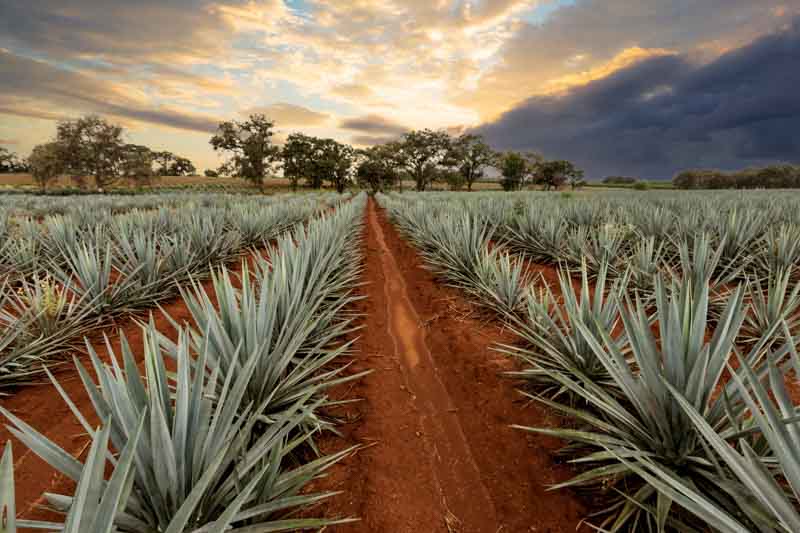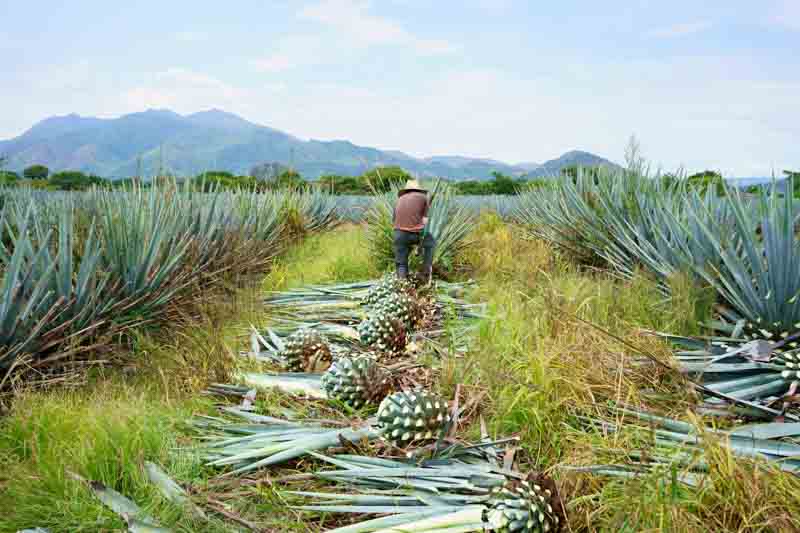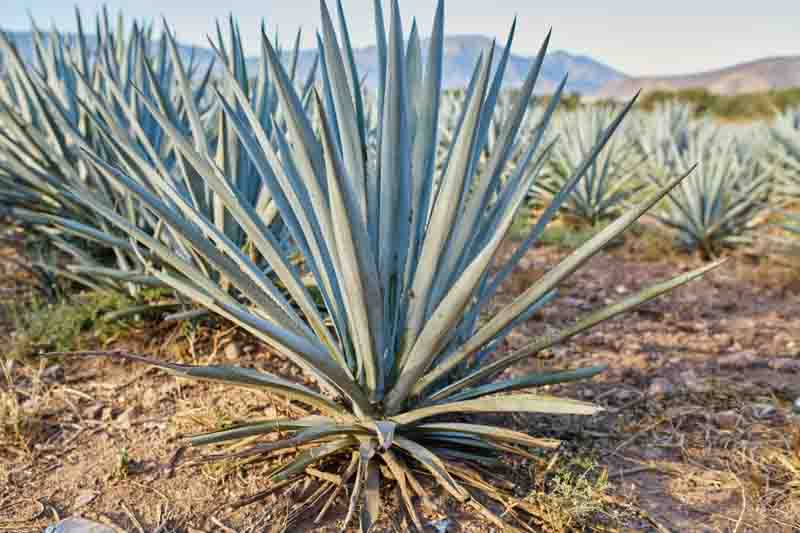Blue Agave, Tequila Agave, Weber's Blue Agave, Agave angustifolia subsp. tequilana, Agave angustifolia var. pes-mulae, Agave palmaris, Agave palmeris, Agave pedrosana, Agave pes-mulae, Agave pseudotequilana
Agave tequilana (Blue Agave) is a succulent plant recognized for its large rosettes of sharp, blue-green leaves. It’s famed as the primary source of agave nectar and tequila.
Native: Native to Jalisco, Mexico, and surrounding areas, Blue Agave thrives in high-altitude regions with sandy soils. It belongs to the Asparagaceae family, along with yuccas or hostas.
Plant Type and Habit: This succulent plant forms a large rosette of spiky fleshy leaves, growing singularly without branching.
Size: Fast-growing, mature plants can reach 5-8 feet (150-240 cm) in height and spread, depending on growing conditions.
Flowers: Blue Agave produces a tall flower spike, up to 20 feet (6 meters) high, with yellow flowers. Flowering occurs once in the plant’s lifetime, typically after 5-10 years. After flowering, it produces capsules containing small, black seeds. This plant is monocarpic: The rosette dies after flowering, leaving offsets to continue the life cycle.
Foliage: Its striking blue-green leaves are long, up to 7 feet (210 cm), narrow, and have dark brown marginal teeth and a sharp brown terminal spine.
Hardiness: It’s hardy in USDA zones 9 through 10, requiring a warm climate to thrive
Uses: Blue Agave is primarily cultivated for producing tequila. The sap is fermented and distilled. Agave nectar, a sweetener, is also produced from its sap. Plant away from foot traffic: the needle-sharp spines on the leaf tips can be hazardous to humans and pets. Don’t plant this Agave near paths or walkways.
Wildlife: The flowers are pollinated by the greater long-nosed bat, insects and hummingbirds.
Deer and Rabbit: Its sharp leaves deter deer and rabbits, making it an excellent choice for areas plagued by these pests.
Toxicity: The sap can cause skin irritation in some people, and the sharp leaves can pose a physical hazard. Use caution, safety glasses, long sleeves, long pants, well-covered shoes, and gloves when cutting this plant.
Drought Tolerance: The sap can cause skin irritation in some people, and the sharp leaves can pose a physical hazard. Extremely drought-tolerant, it is well-suited to arid climates and xeriscaping.
Invasiveness: Not considered invasive in its native range but should be managed carefully in cultivation to prevent unwanted spread.
Benefits: Beyond tequila production, it’s used in landscaping for its drought tolerance and dramatic appearance. It also contributes to soil stabilization.

Vast field of Blue Agave (Agave tequilana)
Tequila is exclusively produced from ‘Weber Azul’, a specific cultivar of Agave tequilana. This cultivar is distinguished by its larger size and blue-gray hue. It grows rapidly and produces offsets prolifically, offering agricultural benefits. The tequila-making process begins between the plant’s seventh and fourteenth year when the heart (piña), weighing 40–90 kg, is harvested. The piña is then heated to convert inulin into sugars, which, after pressing, yields the sugary liquid aguamiel. This is fermented and distilled into tequila. Additionally, tequila can be made from a mix of 51% agave sugars and 49% other sugars, known as Mixtos.

Workers harvest Agave tequilana, meticulously cutting the blue agave plants to extract the heart (piñas)
Growing and caring for Agave tequilana, or blue agave, involves understanding its basic needs for optimal growth and health:
Light: Requires full sun for best growth and health. It thrives in bright, direct sunlight.
Soil: Prefers well-draining, sandy or rocky soil. Poorly draining soils can lead to root rot.
Water: Drought-tolerant once established. Water sparingly, allowing the soil to dry out completely between watering.
Fertilizer: Minimal fertilization needed. If desired, apply a balanced, slow-release fertilizer once a year in the spring.
Pruning: Generally not required, but dead or damaged leaves can be removed to maintain appearance and health.
Propagation: Easily propagated from offsets (pups) that form around the base of the plant. Separate pups in the spring or early summer and plant them directly in well-draining soil.

Agave tequilana, while robust, can face certain pests, diseases, and common issues in cultivation. Here’s an overview:
Agave Snout Weevil (Scyphophorus acupunctatus): A significant pest that burrows into the agave, laying eggs that hatch into larvae, which then eat the plant from the inside, often leading to the plant’s collapse.
Agave Mite: Causes discoloration and deformity of leaves.
Mealybugs: They are small, soft-bodied insects covered in a white, cottony substance, feeding on the sap of Agave tequilana and weakening the plant. Control includes wiping them off or using insecticidal soap.
Scale insects: They latch onto Agave tequilana, sucking the plant’s sap and causing yellowing leaves and stunted growth. Management involves scraping them off or applying horticultural oil or neem oil.
Root rot: Primarily caused by overwatering and poor drainage, leading to fungal infections that can kill the plant.
Anthracnose: A fungal disease presenting as sunken, water-soaked lesions on leaves, exacerbated by humid conditions.
Overwatering: Agave tequilana is drought-tolerant and susceptible to root rot if watered too frequently.
Frost Damage: While somewhat cold-tolerant, it can suffer damage or death in temperatures below freezing if not adequately protected.
Salt Buildup: In areas with hard water, salt buildup in the soil can stress the plant, leading to poor growth and leaf burn.
| Hardiness |
9 - 10 |
|---|---|
| Plant Type | Cactus & Succulents |
| Plant Family | Asparagaceae |
| Genus | Agave |
| Common names | Agave |
| Exposure | Full Sun |
| Season of Interest |
Spring (Early, Mid, Late) Summer (Early, Mid, Late) Fall Winter |
| Height |
5' - 8' (150cm - 240cm) |
| Spread |
5' - 8' (150cm - 240cm) |
| Spacing |
60" - 96" (150cm - 240cm) |
| Maintenance | Low |
| Water Needs | Low |
| Soil Type | Loam, Sand |
| Soil pH | Acid, Alkaline, Neutral |
| Soil Drainage | Well-Drained |
| Characteristics | Showy, Evergreen |
| Tolerance | Drought, Deer |
| Attracts | Birds, Hummingbirds |
| Garden Styles | Mediterranean Garden |
| Hardiness |
9 - 10 |
|---|---|
| Plant Type | Cactus & Succulents |
| Plant Family | Asparagaceae |
| Genus | Agave |
| Common names | Agave |
| Exposure | Full Sun |
| Season of Interest |
Spring (Early, Mid, Late) Summer (Early, Mid, Late) Fall Winter |
| Height |
5' - 8' (150cm - 240cm) |
| Spread |
5' - 8' (150cm - 240cm) |
| Spacing |
60" - 96" (150cm - 240cm) |
| Maintenance | Low |
| Water Needs | Low |
| Soil Type | Loam, Sand |
| Soil pH | Acid, Alkaline, Neutral |
| Soil Drainage | Well-Drained |
| Characteristics | Showy, Evergreen |
| Tolerance | Drought, Deer |
| Attracts | Birds, Hummingbirds |
| Garden Styles | Mediterranean Garden |
How many Agave tequilana (Blue Agave) do I need for my garden?
| Plant | Quantity | |
|---|---|---|
| Agave tequilana (Blue Agave) | N/A | Buy Plants |
Create a membership account to save your garden designs and to view them on any device.
Becoming a contributing member of Gardenia is easy and can be done in just a few minutes. If you provide us with your name, email address and the payment of a modest $25 annual membership fee, you will become a full member, enabling you to design and save up to 25 of your garden design ideas.
Join now and start creating your dream garden!
Create a membership account to save your garden designs and to view them on any device.
Becoming a contributing member of Gardenia is easy and can be done in just a few minutes. If you provide us with your name, email address and the payment of a modest $25 annual membership fee, you will become a full member, enabling you to design and save up to 25 of your garden design ideas.
Join now and start creating your dream garden!